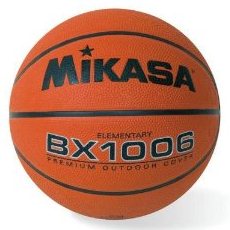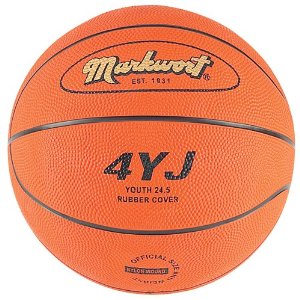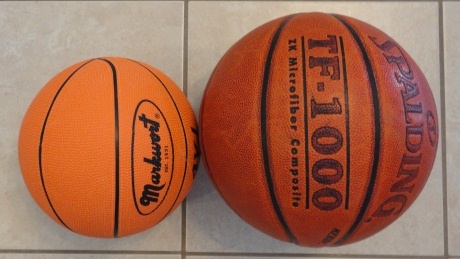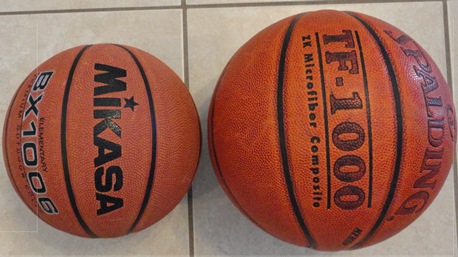Why Standard Youth Basketballs Are Too Heavy and Result in Bad Shooting Habits
Have you put much thought into the size of the basketballs that you use? How much they weigh? And how they affect your players and their development?
I have. I even have a kitchen scale to determine exactly how much each basketball weighs and how it affects players' shooting. I'm going to share what I found to hopefully save you some time and frustration.
In the picture below, you'll see a full size 29.5 inch men's basketball on the left. This basketball weighs 22 ounces. On the far right you'll see a mini ball that weighs only 10 ounces. This is the basketball my son used as a 3, 4, and 5 year old.
| Men's Basketball | Women's Ball | Youth Ball | Size 4 | Another Size 4 | Mini Ball |
| 22 ounces | 20 ounces | 17 ounces | 14 ounces | 11 ounces | 10 ounces |
According to online research and my digital kitchen scale, you can see the weight of each ball in the chart above. There is a huge difference between the 22 ounce men's ball and the 10 ounce mini ball!!
When my son was 5 years old and about 40 lbs. He tried out the third ball from the right (14 ounce Mikasa ball). He could shoot that 14 ounce ball at a 7 ft basket from approx 6-7 feet away with decent form.
When he went any further past 6 or so feet, used a heavier ball, or a higher basket.... one of two things happened....
1) He shot the ball short and couldn't get the ball there.
2) Or his shooting technique went to hell in order to get the ball to the basket.
Self Discovery is a Better Way to Learn
Now, I didn't teach my son how to shoot. He figured it out on his own. I just have him use a really light and small basketball and a little plastic hoop in the basement.
Through experimenting, self discovery, and observation.... he figured out how to shoot with good technique all by himself. I just made sure he didn't shoot with too big of a ball, too far back, or with too high of a hoop.
He was actually a pretty good shooter from about 7 feet... Shot about 65%. Decent form. Nice knee bend. Good rotation. Nice follow through. It is surprising to me but true.
His older sister (7 years old at the time) on the other had has less interest (didn't shoot for fun like he doid) and had't developed good form on her own. It wasn't terrible form but it looked nothing like her younger brother and not nearly as accurate.
The purpose of this article is not to tell you about my kids. But to get you thinking about the size of basketballs that you use and how your kids are learning.
Are you using basketballs that are too heavy? Are you giving kids an opportunity for self discovery?
I see lots of 5 to 10 year old kids shooting at high baskets. And I even see 5 and 6 year olds with youth/junior balls -- and those are still way too heavy.
I am a full grown man (6ft, 200lbs) and can barely shoot a men's basketball from 23 ft with good form. If you think about it, my release point is about 4 feet higher than my sons at the time (because I am so much taller). And I weighed 150 lbs more than him. So to expect him at 5 years old to be able to shoot a 17 ounce youth basketball at a high hoop with good form seems unrealistic.
So we try to get kids using basketballs and hoops appropriate to their age and size. My son started using the 14 ounce ball at age 5 and he actually went back to the 11 ounce ball. When he was 4 years old, he never used anything heavier than 10 ounces. When he was 3 years old, he mostly used nerf balls.
 When my daughter was in the 2nd grade, we used 14 ounce Mikasa ball on the right.
When my daughter was in the 2nd grade, we used 14 ounce Mikasa ball on the right.
For the money, it worked great. They are only $13. We ordered 10 for one of our teams.
I liked the 14 ounce ball because it's bigger than the mini (good for dribbling) yet still fairly light for shooting.
When I looked in local sporting goods and big box stores, I could not find the 14 ounce or 11 ounce basketballs above. So I ordered them online.
 I also ordered this 11 ounce Markwort ball for my son. It's bigger than a mini but almost just as light. The ball works fine -- but one of them we ordered got a little bubble. Not the greatest quality. But for only $12 I didn't mind and it was the perfect size for my son.
I also ordered this 11 ounce Markwort ball for my son. It's bigger than a mini but almost just as light. The ball works fine -- but one of them we ordered got a little bubble. Not the greatest quality. But for only $12 I didn't mind and it was the perfect size for my son.
The 14 ounce Mikasa seemed to be a little better quality. We used them with our 2nd grade team and they worked well.
Size Comparison
Here are a few pictures so you can see the size differences...
11 Ounce Next to a Full Size Men's Ball 22 ounces

14 Ounce Next to Full Size

Recommendations
Based on my experience, here are some suggestions on what size ball you should use...
| Age (Years) | Weight of Ball (Ounces) |
|---|---|
| 0 - 3 | 6 or less |
| 4 | 10 or less |
| 5 | 11-12 |
| 6 | 12-14 |
| 7-10 | 14-17 |
| 11-13 | 17-20 |
Of course this chart is not perfect because every kid matures at a different rate and it depends on the gender of the player. But these are some general guidelines to consider.
If you're not sure the weight of a ball, use a kitchen scale. That's what I did.
Before going with the norm, consider the weight of the ball your players use and how kids learn. Sometimes just putting them in the right environment and allowing self discovery is a better way to learn. In fact, when ever possible, this is a better way to learn. This won't work in all situations. But when possible, it's something I think you should consider.
Related Pages and Helpful Resources:
The Youth Coaching System with Jim Huber
Coaching Youth Basketball - Drills, Offense, Tips, Etc.
Youth Basketball Shooting: 3 Things Youth Coaches & Players Need to Adjust
What do you think? Let us know by leaving your comments, suggestions, and questions...
|
|||||||||||||||||||||||||||||||||




 Facebook (145k Followers)
Facebook (145k Followers) YouTube (152k Subscribers)
YouTube (152k Subscribers) Twitter (33k Followers)
Twitter (33k Followers) Q&A Forum
Q&A Forum Podcasts
Podcasts